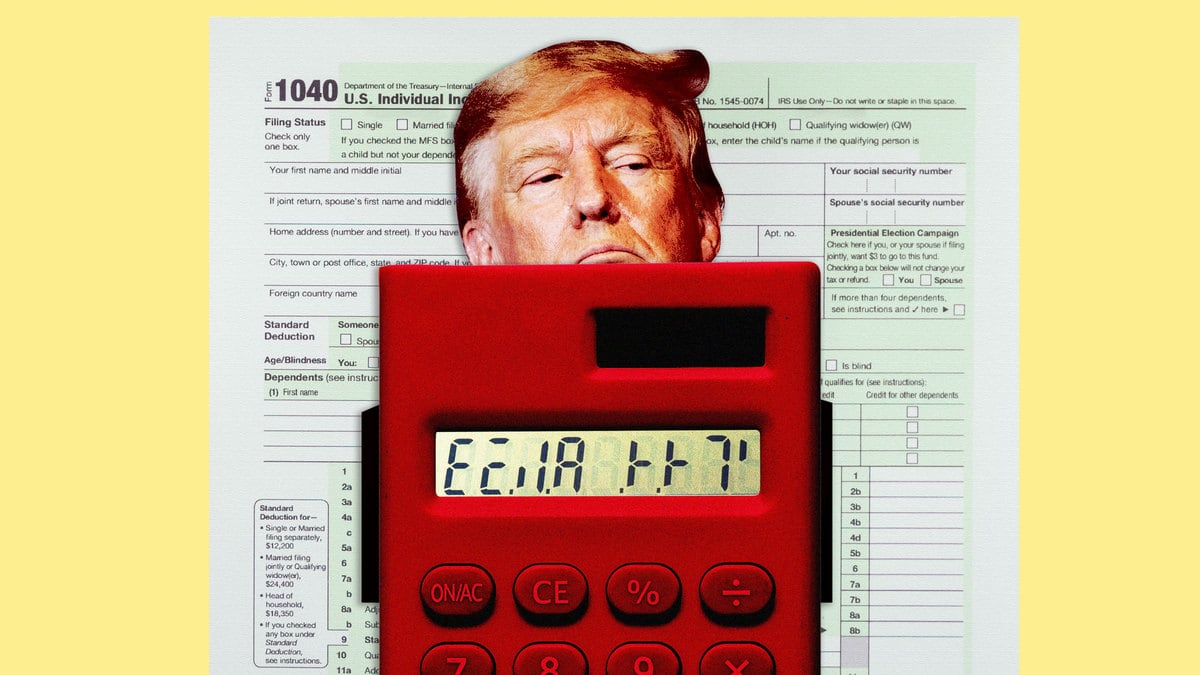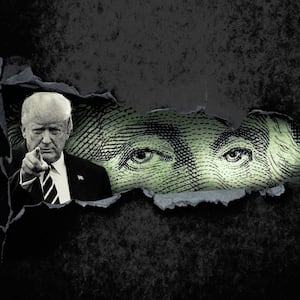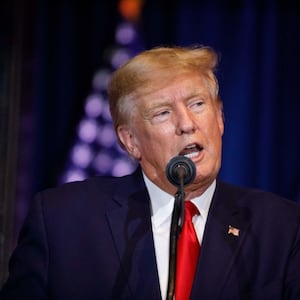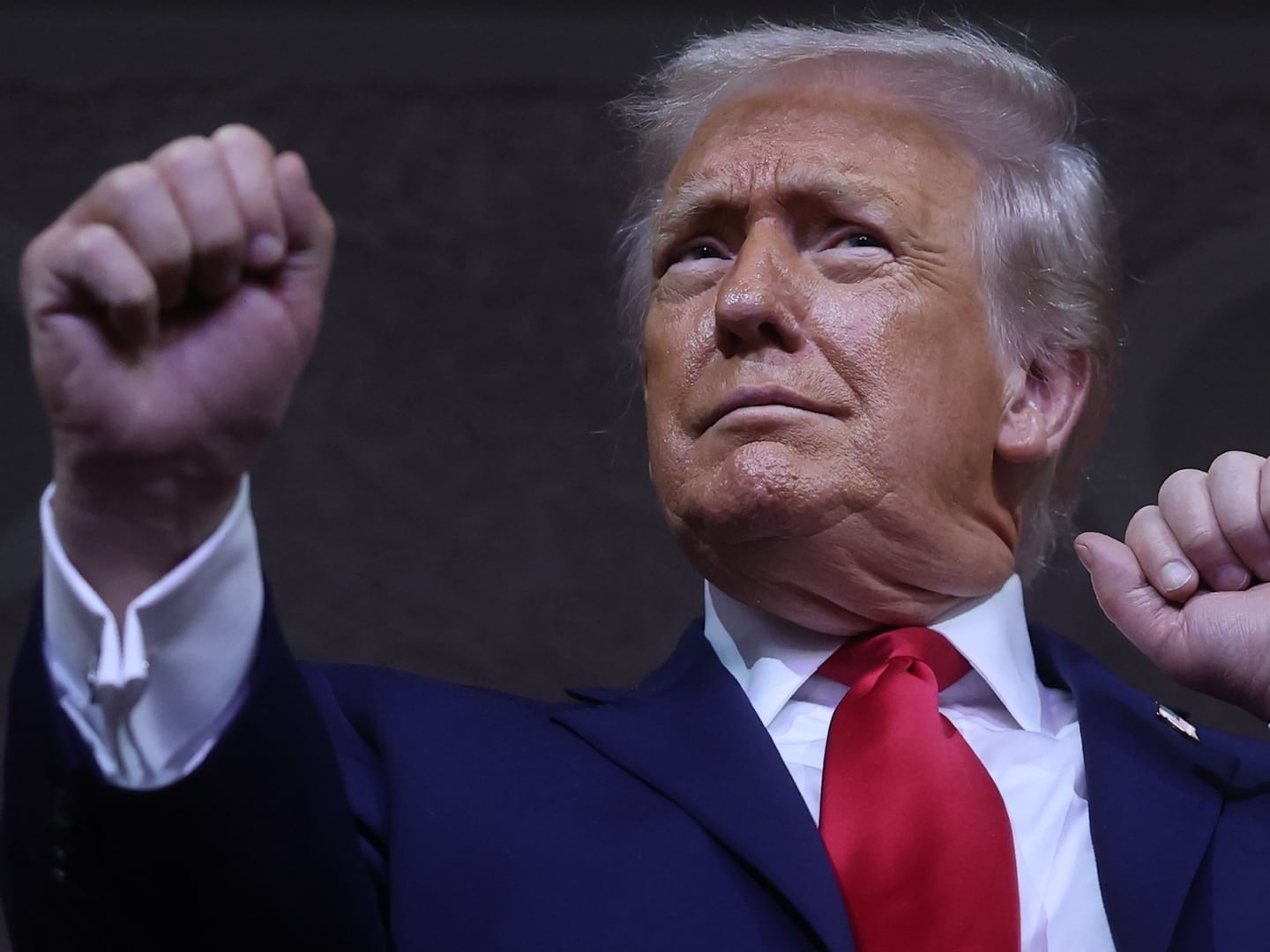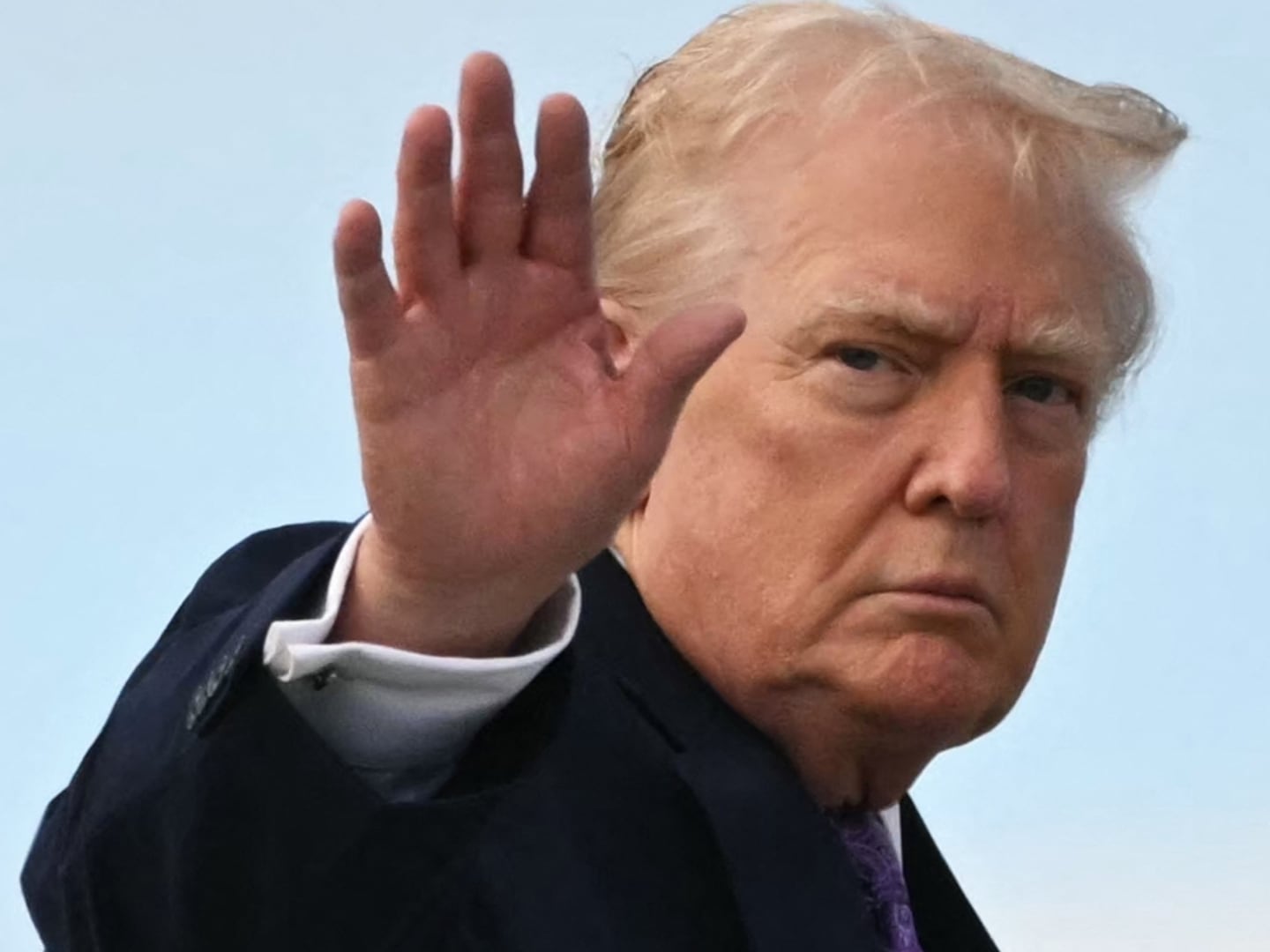When Donald Trump left office in early 2021, he was apparently on much thinner financial ice than almost anyone knew.
That revelation, which three accounting experts confirmed upon reviewing Trump’s 2020 tax return, may help explain some of the financial and political moves the former president has made in the intervening years. Snowballing legal fees, along with other possible legal settlements and judgments, threaten to consume the cash pile he needs to bankroll his business activity, as well as fund a lavish lifestyle and maintain his image of excess—an emperor atop a golden toilet.
How big is that cash pile, exactly?
Accountants caution against reading too much into tax returns of high net worth individuals like Trump—especially ones in the real estate business—because those filings can be extraordinarily complex. That said, all three tax experts interviewed for this article concurred that Trump’s stash on hand at the end of 2020 does not appear to be quite as generous as the returns might make it seem.
While Trump often boasts of being a billionaire—which, in terms of assets, he is—two of the experts who reviewed his returns for this article said that as his presidency came to its tumultuous end, it appears Trump, depending on interest rates, may have had immediate access to anywhere between $30 million and $100 million, with that amount itself scattered across hundreds of entities.
That bottom line was reflected in new documents filed last week by New York Attorney General Letitia James in her $250 million fraud lawsuit against Trump, three of his adult children, and his businesses. Those documents show that Trump—a billionaire on paper—only had control over about $65 million in liquid assets as he prepared to depart the White House.
The cash flow discrepancy, according to three accounting experts who reviewed Trump’s 2020 tax returns, is significant, and can be chalked up to one simple fact: The vast majority of Trump’s ordinary income is reported as interest income and derived from pass-through entities. His tax returns are not intended to report if this income was actually distributed to him—they only indicate what income is attributed to him as an owner or investor.
That fact is central to James’ lawsuit, which argues that these funds may not actually equate to liquidity—and that when Trump applied for loans, he played up those “restricted funds” as his own money in order to help secure the loans. In reality, the suit says, a significant portion of what Trump called “his” cash was wholly controlled by another entity—the real estate behemoth Vornado—which Trump could not unilaterally access if he, or his businesses, needed to find some funds.
“Internal Trump Organization records acknowledge that cash residing in the Vornado Partnership Interests was not Mr. Trump’s to access at his whim,” the new filing reads.
The filing goes on to cite those internal records, which admit that “distributions are at the discretion of Vornado” and “at this point we do not have all of the data that goes into Vornado’s decision making, thus we are attributing no distribution for these properties.”
Citing Trump Organization financial statements, James points out that of the $92.7 million that Trump held in liquid assets in 2020, $28.25 million of that amount was tied up in “partnership entities Mr. Trump did not control as Mr. Trump’s own liquidity.” In some years, she said, “these restricted funds accounted for almost one-third of all the cash reported by Mr. Trump.”
Mark S. Gottlieb, a forensic accountant and tax law expert in Manhattan, told The Daily Beast that if the attorney general’s premise is correct and Trump does not have access to portions of the 2020 income attributed and taxed to him, those amounts are tantamount to “phantom income.”
“As phantom income, he can’t touch it, feel it, smell it, or use it,” Gottlieb said.
In 2020—when Trump’s hospitality-oriented businesses were reeling from the pandemic and he paid no income tax—that phantom cash may have accounted for as much as 90 percent of the income, as represented on the return.
Gottlieb pointed out that Trump’s 2020 federal income tax returns show that, outside of the $10.6 million in interest income—an “impressive” number on its face—Trump reported very little in the way of dividends, and his only other substantial income derived from his $400,000 presidential salary. (The New York Times reported that Trump may have kept his salary that year, breaking his promise to donate his federal wages to charity.)
But a huge chunk of that interest income, about $9.74 million, appears to have come from partnership entities related to properties controlled by Vornado, according to the returns. As James’ lawsuit points out, Trump is a minority member in those properties, has no control over his stake, and cannot access it whenever he wants—in other words, phantom income.
“That headline $10.6 million is nice, but it appears to be mostly interest income from pass-through entities related to Vornado, not entities Trump actually controls and manages,” Gottlieb said. “The self-proclaimed billionaire only earned an actual income of around a million dollars. But for his wages as president and his dividends from those inaccessible partnerships, Trump’s actual income that year was more like $500,000 or $600,000. Not a lot of money for a billionaire.”
Francine Lipman, a tax law expert at the University of Las Vegas Nevada, concurred with Gottlieb.
“When you look at this tax return, the first impression is, boy that’s a lot of interest income! But then you do a deep dive and the vast majority is from pass-through entities, and some of these partnerships are more second- or third-degree partnerships where he’s not just going to be able to put money from left pocket to his right pocket,” Lipman said.
“There appears to be very little in banks that is actually accessible. Between the banks that we can recognize—Professional Bank? What is that? I haven’t heard of it—it looks like he’s got around half a million in interest income that he can actually touch. Not $10 million,” she said. (Trump appears to have stashed most of his money in Capital One; Professional Bank, a Florida lender which once fronted Trump $18 million to buy a home next to Mar-a-Lago, severed its relationship with him in the wake of the Jan. 6 insurrection.)
Trump’s overall liquidity—essentially, his cash and readily convertible assets—can be derived from his interest and dividend income. And that math, according to Gottlieb and Lipman, suggests he could have had access to as much as $100 million and as little as $30 million, depending on interest rates and other variables.
Forensic accountant Bruce Dubinsky warned against making a guess at Trump’s true assets, citing the many unknowns that can lurk in complex returns. But Dubinsky did agree with the broader view that the restricted access was significant, especially in light of Trump’s rampant arrogations to extreme wealth.
“It appears from a review of Trump’s tax returns, based on the interest and dividends he was reporting, that a large portion of the interest income was coming from various partnerships in which he apparently was not the controlling partner. As a result, he would not have had ready access to the underlying funds generating that interest income from those partnerships,” Dubinsky told The Daily Beast. “Accordingly, based upon my rough calculations taking that interest income out of the equation, his true liquid net worth was significantly less than the amount he has touted publicly.” (While those claims appear to fluctuate with the seasons, the amount would represent a sharp dive from the $793 million Trump told Forbes he had in cash in 2015.)
Of course, Trump paid no taxes in 2020, because he took advantage of a number of loopholes, some of them specific to real estate operators. Those deductions allowed him to declare a personal loss of nearly $5 million on an income of about $11.1 million.
Asked about the cash flow, Trump spokesperson Stephen Cheung provided a statement trashing this outlet and calling “President Trump” a “self-made, successful businessman.”
Trump told The New York Times in December, after the public release of his returns, that the documents “once again show how proudly successful I have been and how I have been able to use depreciation and various other tax deductions as an incentive for creating thousands of jobs and magnificent structures and enterprises.”
The 2020 snapshot offers a view of Trump’s cash on hand at a critical time—just as he was departing the White House for post-presidential life at his Mar-a-Lago resort compound. And for someone who lives such an extravagant lifestyle—while running companies that require cash flow to operate and facing mounting legal costs, possible judgments, and a sluggish business environment—it wasn’t the rosiest picture.
Mar-a-Lago itself captures the moment: The club does generate money, but not a lot—only about $100,000 profit in 2020, according to the tax records—and requires substantial overhead (i.e., cash) to carry out its daily operations.
Jordan Libowitz, communications director for government watchdog Citizens for Responsibility and Ethics in Washington, told The Daily Beast that Trump’s financial status helps explain some of the financial and political moves he’s made since leaving office.
“2020 is an interesting year. He’s all-in on the hospitality industry, which was falling apart amid the pandemic, even with all the people trying to patronize his properties. And it would not surprise me if he’s struggling to access cash, especially as banks have become reticent to lend him money. It’s why he needs Truth Social to come through,” Libowitz said, referring to the troubled social media startup that Trump partnered with in 2021.
Libowitz also noted that Trump made other big moves, such as selling off the Trump International Hotel in Washington, D.C., which had become a financial burden, incurring $70 million in losses.
Trump was also turning to political channels for financial relief. In the time since the election, he socked away more than $100 million in his Save America leadership PAC—a type of political committee notorious for being “personal slush funds.” He put hundreds of thousands of donor dollars back into his own pockets by spending money at his properties, and he tapped PAC funds to subsidize some of his legal costs—and those of select Jan. 6 witnesses—to the tune of about $9.7 million, The Washington Post reported in December. Trump has also leaned on the Republican National Committee for help covering some of his legal bills.
“If you look at the history of Trump, the only thing he hates more than paying taxes is paying his bills,” Libowitz said. “When he got fined for his giant Mar a Lago flagpole, he used nonprofit donations to pay it off. So if he can use someone else’s money, he will. Why jump through these hoops with the RNC when for a billionaire it’s comparatively very little money? Well, when it’s something like 5 percent of what you can access, that is a lot of money.”
Beyond the legal fees, Trump also faces the prospects of possible losses in court. Not only is James suing him for $250 million, but he faces various civil suits, like twin sexual assault claims from E. Jean Carroll and a Jan. 6 action from Capitol Police officers and Democratic lawmakers. Gottlieb, the forensic accountant, said that, given the nature of the allegedly restricted funds, Trump’s legal fees could strain his finances.
“Trump’s potential legal fees can certainly add up. It is unclear from his remaining interest and dividend income, excluding the Vornado interest income, if he or the entities he controls has the liquid funds to support these ongoing costs,” Gottlieb said.
Libowitz noted that Trump likely doesn’t want to have to continue to sell off properties, which are struggling—with the notable exception of the Vornado properties. Put simply: his business empire simply isn’t what it used to be.
“The licensing fees have dried up because no one wants to be associated with him. How is he going to get income?” Libowitz wondered. He pointed to a line from Wal-Mart founder Sam Walton, when he shrugged off the 1980s market crash, his business having lost more money—on paper—than anyone else.
“It’s paper anyway,'' Walton said at the time. “It was paper when we started, and it’s paper afterward.”

